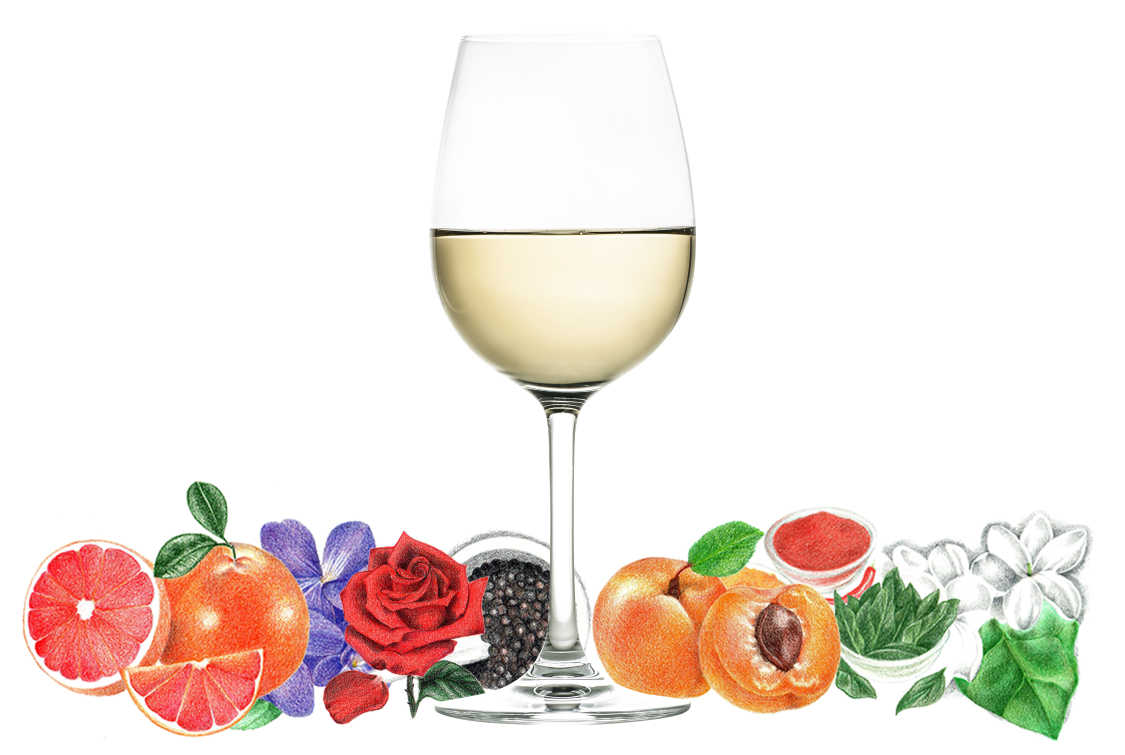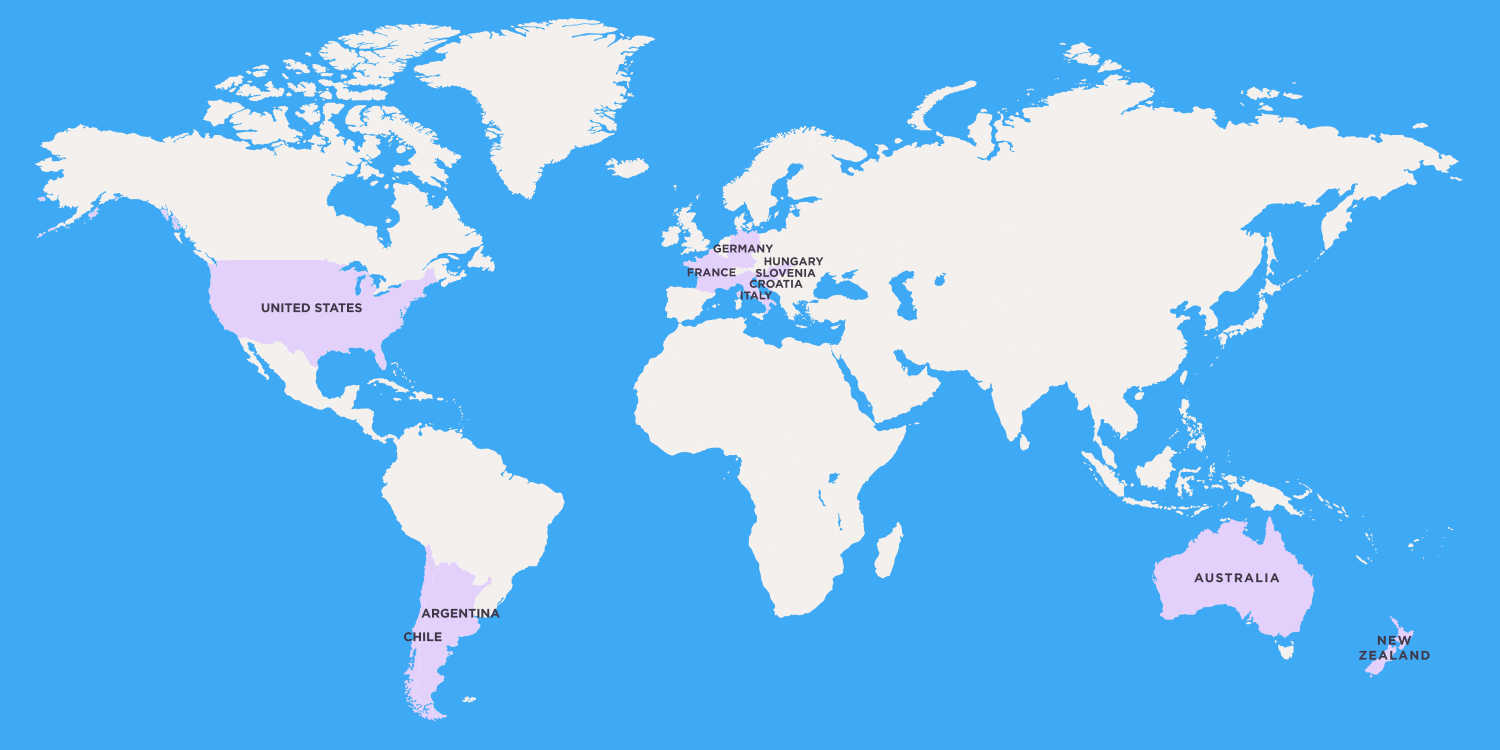Gewürztraminer
Gewürztraminer is a rose-colored wine grape variety known for its beautiful bouquet of aromas.
Gewürztraminer is a rose-colored wine grape variety known for its beautiful bouquet of aromas. The most well-known examples of Gewürztraminer come from Alsace in the foothills of the Vosges mountains in northeastern France along the German border and are used to make white wines with a heavy, luscious mouthfeel and huge aromas.
Difficult to make well, the best examples are off-dry with a perfume of fresh-cut roses, lychee, apricot, black pepper, citrus peels, and tea. The wine must, however, have enough acidity and structure to support the bold nose. Unlike some more well-known grapes like Merlot, Cabernet Sauvignon, and Chardonnay that can grow anywhere, Gewürztraminer needs cool-climate vineyards that are full of sunshine with almost no rainfall. The vines need to be restricted for the best results.

Take The Quiz
Learning about different wine varietals and regions is fun. Take the quiz now to explore wines matched to your unique palate.
Take The QuizIN THIS ARTICLE:
Want personalized wines?
Get your first box of wines for $44.95 + free shipping.

History of Gewürztraminer
The Gewürztraminer (pronounced guh-vertz-trah-mee-ner) name is derived from its ancestor, Traminer, and the German word Gewürz which means spice.
With a somewhat convoluted history, Gewürztraminer is a descendent of the Traminer grape that came from South Tyrol (Südtirol also known as Alto Adige), an autonomous province in the far north of Italy, and slowly changed as it traveled over the Alps.
The first official mention of Gewürztraminer winemaking is in German records from 1827, and very soon after it was noted in Alsace.
While it is grown across the world, its overall footprint is fairly low. Good Gewürztraminer is found in Alsace, Germany, Austria, Hungary, Italy, New Zealand, and a few places in the United States. Gewürztraminers with higher acidity can stand a few years of aging, but most are made to be enjoyed young.
What does Gewürztraminer taste like?
Dry Gewürztraminer wines made in the Alsatian style are sensual with scents of lychee, rose petals, apricot, tropical fruit, and pepper that play off of a viscous texture and off-dry sugar content.
Cooler, higher climates have recently excelled at making a different style of more delicate Gewürztraminer. These wines are toned down and have higher acid. That being said, these are still rich wines when compared with most white wines.
In rare cases, Gewürztraminer is used to make sweet wine in Alsace (also called Sélection de Grains Nobles or SGN) from grapes that have been affected by "noble rot," although its thick skin generally makes this a difficult process.
Fun Fact
Gewürztraminer wines are sometimes lightly effervescent
Gewürztraminer Characteristics
The most notable Gewürztraminer characteristic is the heady aroma. There are very few wines that can even come close to matching Gewürztraminer for sheer pungency in a glass. The berries can be anywhere from pale pink, rimmed with orange, to more rose pink and even bordering on purple.
The thick grape skins mean that sometimes this wine can reach very high sugar and alcohol levels, which makes controlling it in the vineyard very important for winemakers looking to make a particular style.
Gewürztraminer wines showcase terroir more readily than some of the other more “international” varietals.
Fun Fact
Gewürztraminer grapes have thick skins, but can still make fabulous sweet wines.
Gewürztraminer Nutritional Facts
The nutritional values in Gewürztraminer wines varies greatly depending on two main factors: alcohol and sugar. The more sugar present in a wine, the more carbohydrates.
Gewürztraminer can be made in many different styles, and some Gewürztraminer is sweet and some Gewürztraminer is dry. The alcohol in Gewürztraminer can depend on how ripe the grapes were when harvested if the winemaker added extra sugar, and how long it was allowed to ferment. Gewürztraminer wines are generally a medium to medium-high alcohol wine.
How to Serve and Store Gewürztraminer
Serving Gewürztraminer can be done simply. Enjoy at cellar temperature (55 degrees Fahrenheit). If you want to experience the wine through multiple stages we recommend thoroughly chilling the wine and allowing it to warm as you drink it, this will release the scents and in well-made examples, you will get the full aromas bursting from the glass. That being said, this is all personal preference. Enjoy your wine how you like it.
Once your wine is cooled it is time to open the bottle. Most likely you will need a standard corkscrew, but If you have a particularly old bottle, you might prefer to use a two-prong Butler's thief cork puller.
Gewürztraminer does not typically need to be decanted, but if you are drinking an older bottle you could consider decanting it before serving in standard wine glasses.
Gewürztraminer should be stored in a cool place that does not receive direct sunlight, and preferably in a wine refrigerator or cellar. 55 degrees Fahrenheit is the median temperature wine should be stored if you wish to age the bottles. What matters most is consistency. Do not store your Gewürztraminer in a place that receives direct sunlight, heat, or too much humidity.
Most Gewürztraminer wines are not meant to be aged. Some bottles from Alsace can make it ten years in a cellar, and late harvest (vendange tardives) or Sélection de Grains Nobles Gewürztraminers can last multiple decades when stored correctly.
What to Pair with Gewürztraminer
Pairing wine has some general rules, but we think the most important rule is to drink Gewürztraminer with the food you like. It is also a wine that stands up just fine on its own. If you are looking for specific suggestions for food pairings with Gewürztraminer, we would suggest trying it with rich or spicy foods. A classic Alsatian pairing is pâté, but Gewürztraminer does well with spicy, Asian flavors too. Try it with fragrant Thai dishes or Sichuan cuisine.
Gewürztraminer Wine Regions Around the World
Gewürztraminer is grown all over the world, but it is not an international grape like Chardonnay, Cabernet, or Merlot. The difficulty of making good Gewürztraminer means that it is not often grown as a moneymaker for a winery, but as a passion project for talented winemakers. Here is a brief overview of where it is growing.
France:
The quintessential Gewürztraminer wines come from Alsace in the far eastern reaches of France. The wine is incredibly fragrant with notes of lychee and other tropical fruits, cream, flowers, and black pepper. Styles range from dry to off-dry and even to sweet dessert wines in multiple styles.
Fun Fact
The only grapes allowed in an Alsace Grand Cru wine are Riesling, Muscat, Pinot Gris, and Gewürztraminer
Italy:
Gewürztraminer is not an uncommon grape in Northern Italy in the vineyards of Alto Adige (Sudtirol), although the various grape mutations come in different shades and grow in white, pink, and red varieties. The wines from this region are less aromatic than Alsatian examples.
Germany:
Just over the border from Alsace is Germany where we find mixed plantings of Gewürztraminer and “Roter Traminer” which make wines that are much less fragrant and much more plain. The best examples come from the Pfalz region.
Other European Gewürztraminer:
Some small amount of Gewürztraminer are grown in the wine regions of Eastern Europe. Going under various names you will find it across Hungary, Slovenia, and Croatia.
United States:
Gewürztraminer is not often found in the United States, but there are a few regions that have been making great examples of the hard-to-farm grape. California Gewürztraminer, particularly those coming from the cooler Sonoma Coast or around Monterey, are quite nice, as are some examples coming out of Napa, Oregon, and even the Finger Lakes region of New York. The best New World examples invariably come from cooler vineyard areas.
New Zealand and Australia:
New Zealand has a fantastic climate for making Gewürztraminer. The cool weather and large amounts of sunshine mean that the grapes can ripen well without struggling to develop sugar. Like in the U.S., the best Australian examples come from the coolest regions of the country.
South America:
Recently there have been decent examples coming out of Mendoza, Argentina and the southernmost vineyards of Chile.
IN THIS ARTICLE
Want personalized wines?
Get your first box of wines for $44.95 + free shipping.


WinePrint™ by Firstleaf
Are you looking to learn more about your wine preferences? Check out our Wine Print for an in-depth look at your personal tasting profile. Discover your favorite wines, varietals, regions, and tasting notes and get personalized recommendations wherever you are.
Learn More
